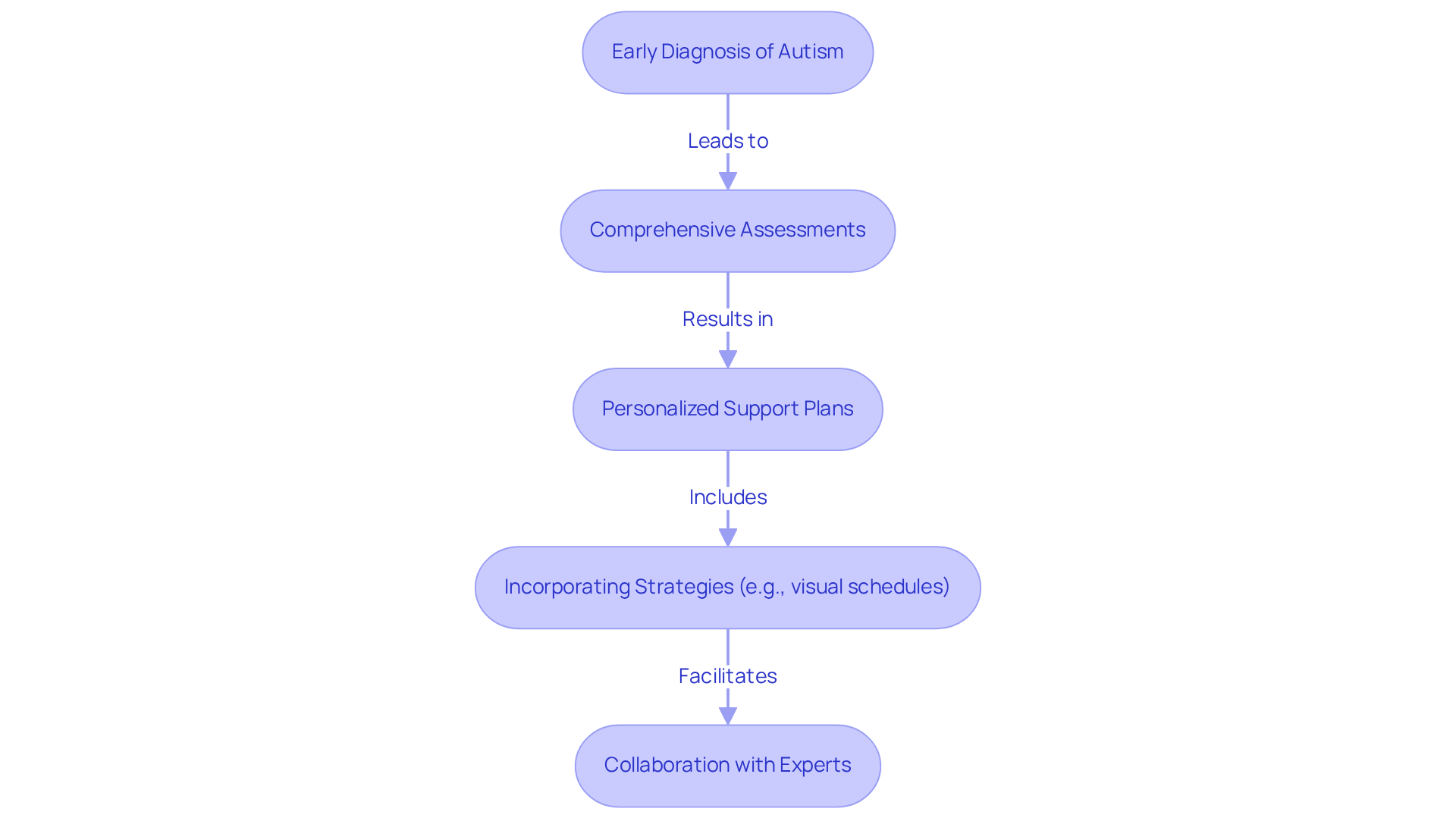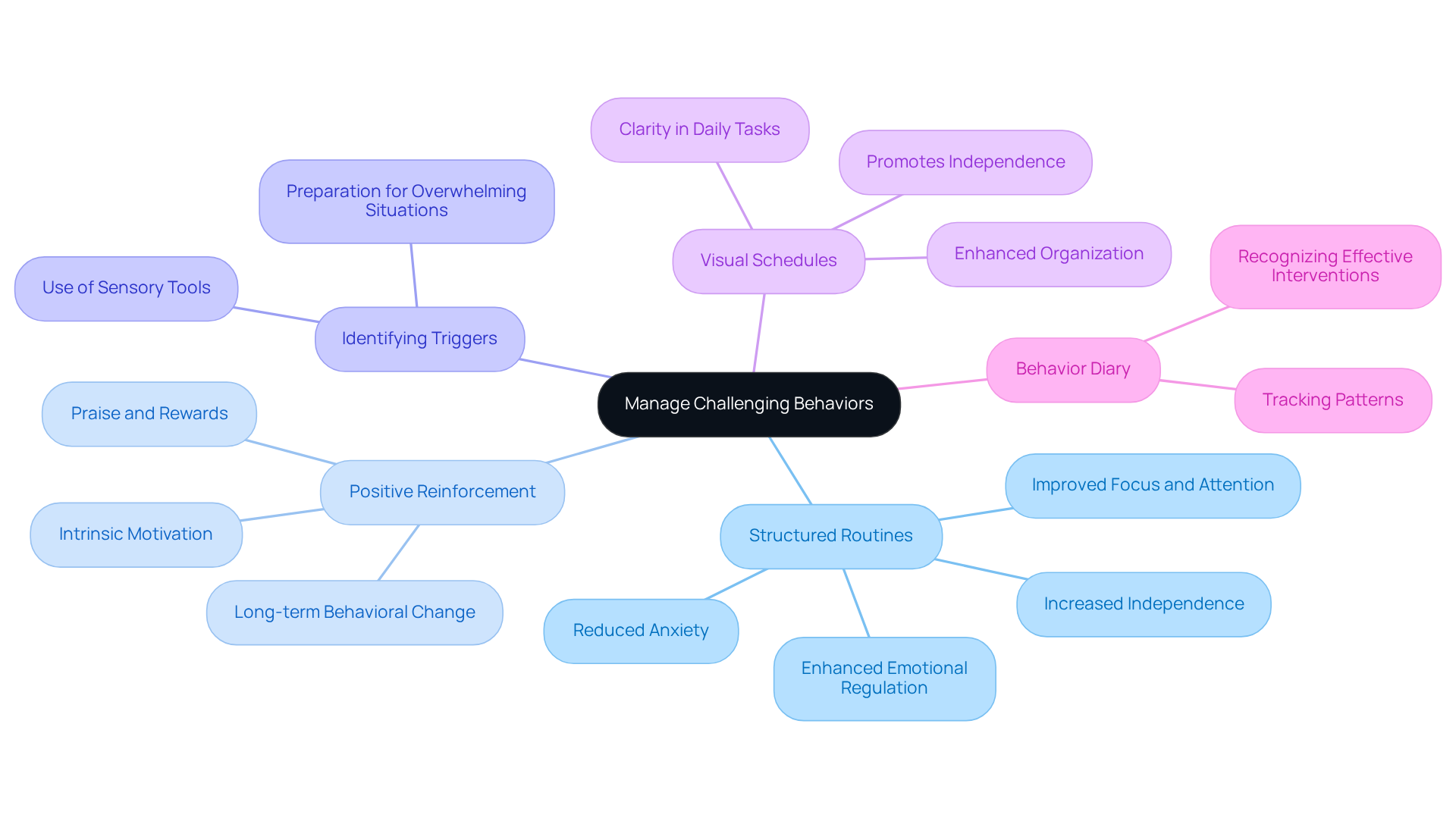Overview
In this article, we explore four essential strategies designed to empower parents of children with autism in their journey of support.
- First and foremost, understanding autism through early diagnosis is crucial. This foundational step not only aids in recognizing the unique needs of your child but also sets the stage for effective interventions.
- Next, implementing effective communication strategies can significantly enhance interactions with your child, fostering a deeper connection and understanding.
- Building a supportive community is another vital strategy. Connecting with other parents and professionals who share similar experiences can provide invaluable insights and emotional support.
- Lastly, managing challenging behaviors requires patience and tailored approaches, as every child is different. These strategies are backed by research and real-life examples that highlight their effectiveness in promoting children's development and nurturing meaningful relationships.
As you navigate the complexities of autism, remember that tailored approaches and community engagement are key. By embracing these strategies, you can create a supportive environment that not only benefits your child but also enriches your family's journey together.
Introduction
As awareness of autism spectrum disorder (ASD) continues to grow, many parents find themselves facing the daunting task of navigating a complex array of support and resources. Recognizing the significance of early diagnosis and personalized interventions can profoundly shape a child's developmental journey, unlocking their potential for social and cognitive advancement. Yet, with a wealth of information and strategies at their fingertips, how can parents discern the most effective approaches tailored to their unique circumstances? This article explores four vital strategies aimed at empowering parents of children with autism, fostering a nurturing environment that enhances support and encourages positive outcomes.
Understand Autism: Importance of Early Diagnosis and Customized Support
Recognizing autism spectrum disorder (ASD) early is crucial, as it opens the door to timely interventions that can significantly enhance a young person's development. Research shows that children diagnosed before the age of 2.5 years experience an impressive 65% improvement in social communication skills, nearly triple the 23% enhancement seen in those diagnosed later. As autism parents, seeking comprehensive assessments from qualified professionals is vital for understanding your child's unique needs. These evaluations can lead to the creation of personalized support plans that leverage your child's strengths while addressing their challenges.
For example, incorporating visual schedules and structured routines can greatly assist children with developmental disorders in managing daily activities. Early interventions have been proven to boost both social functioning and cognitive abilities. Collaborating with experts who provide tailored strategies is essential for unlocking the full potential of young individuals facing developmental hurdles. This ensures they receive the necessary support for their growth and success.
Remember, autism parents, you are not alone in this journey—reaching out for help is a powerful step towards securing your child's brighter future.

Implement Effective Communication Strategies for Better Connection
To foster meaningful interactions with children on the spectrum, it's essential for parents to embrace approaches that align with their child's unique expression style. By using clear and concise language, paired with visual aids, comprehension can significantly improve. For example, visual schedules can effectively outline daily activities, helping children anticipate transitions and reduce anxiety. Research shows that introducing augmentative and alternative communication methods early on can lead to positive outcomes, making visual aids a crucial element in supporting communication development for individuals with autism.
Moreover, studies reveal that 50-75% of children receiving intensive ABA therapy for two or more years demonstrate significant improvements in cognitive and adaptive functioning. Incorporating play-based learning creates a relaxed environment, allowing young learners to express themselves more freely. Practicing patience and providing extra processing time for responses fosters a supportive dialogue atmosphere. Engaging in activities that capture a child's interest can further enhance interaction and encourage verbal expression.
Family involvement in therapy is vital, as it allows for a more tailored approach to communication strategies, ensuring they meet the specific needs of the child. Consistent use of visual aids is crucial, and it's important to adapt them to the child's preferences to avoid common misapplications. By embracing these strategies, parents can create a nurturing environment where their children feel understood and supported.

Build a Supportive Community: Collaborate and Share Resources
Creating a nurturing community is essential for parents navigating the challenges of autism. Engaging with fellow parents, experts, and dedicated groups can provide invaluable support. Consider joining local assistance groups or online forums where you can share experiences and resources. These connections can lead to meaningful relationships with others who understand your journey.
Participating in community events, workshops, and seminars offers insights and opportunities to learn from those facing similar challenges. Collaborating with professionals, such as therapists and educators, can further enhance your support network. For instance, organizing sensory-friendly outings or playdates can create inclusive environments where children can interact and develop their skills in a comfortable setting.
By sharing resources and strategies, parents can collectively navigate the complexities of raising a child with developmental challenges. Together, we can foster a supportive community that ultimately leads to improved outcomes for our children. Let's take the first step towards building these connections—reach out, share your story, and explore the resources available to you.
Manage Challenging Behaviors: Proven Strategies for Positive Outcomes
Addressing difficult behaviors in youngsters with autism requires a thoughtful approach that emphasizes consistency and positive reinforcement. Establishing a dependable routine is crucial, as it helps children understand expectations and significantly reduces anxiety. Research from Golden Steps ABA reveals that children with structured routines are 47% more likely to maintain strong social-emotional health as they mature. Positive reinforcement strategies, such as praise or tangible rewards for desired behaviors, not only encourage the repetition of those behaviors but also nurture intrinsic motivation and self-esteem.
Identifying triggers that lead to challenging behaviors is vital. For instance, if a child finds crowded environments overwhelming, preparing them beforehand and providing sensory tools can ease those feelings. Additionally, visual schedules can enhance organization and promote independence, enabling young individuals to better navigate their daily routines. Keeping a behavior diary allows parents to track patterns and recognize effective interventions, deepening their understanding of their child's needs. Research shows that children undergoing ABA therapy report significant improvements in social (85%), communication (90%), and academic skills (75%). By prioritizing positive behavior support and fostering a nurturing environment, parents can play a pivotal role in their child's growth and development, ultimately enhancing emotional regulation and independence.

Conclusion
Supporting a child with autism spectrum disorder (ASD) is a deeply meaningful journey that encompasses understanding, effective communication, community engagement, and behavior management. By prioritizing early diagnosis and tailored interventions, parents can profoundly influence their child's developmental path. The significance of personalized support is immense, as it enables strategies that address the unique needs of each child.
In this article, we have explored essential strategies, such as:
- Effective communication techniques
- Building a supportive community
- Managing challenging behaviors through positive reinforcement
Each of these components is vital in creating an environment where children can flourish. Parents are encouraged to:
- Use visual aids
- Connect with peers and professionals
- Establish structured routines
to enhance their child's experiences and outcomes.
Ultimately, the journey of parenting a child with autism can be enriched through collaboration and shared resources. By reaching out to others, embracing effective strategies, and staying committed to understanding their child's needs, parents can cultivate a nurturing atmosphere that fosters growth and development. Taking proactive steps today will not only benefit the child but also help build a supportive community that uplifts all families navigating similar journeys.
Frequently Asked Questions
Why is early diagnosis of autism spectrum disorder (ASD) important?
Early diagnosis of ASD is crucial as it enables timely interventions that can significantly enhance a young person's development. Children diagnosed before the age of 2.5 years show a 65% improvement in social communication skills, compared to a 23% improvement in those diagnosed later.
What should parents do to understand their child's needs regarding autism?
Parents should seek comprehensive assessments from qualified professionals to understand their child's unique needs. These evaluations can help create personalized support plans that leverage the child's strengths while addressing their challenges.
How can structured routines assist children with developmental disorders?
Incorporating visual schedules and structured routines can greatly assist children with developmental disorders in managing daily activities, helping them navigate their environment more effectively.
What benefits do early interventions provide for children with autism?
Early interventions have been proven to boost both social functioning and cognitive abilities, allowing children to develop essential skills more effectively.
How can parents ensure their child receives the necessary support for growth?
Collaborating with experts who provide tailored strategies is essential for unlocking the full potential of young individuals facing developmental hurdles, ensuring they receive the necessary support for their growth and success.
What is the emotional support available for parents of children with autism?
Parents are encouraged to reach out for help, as they are not alone in their journey. Seeking support is a powerful step towards securing a brighter future for their child.




